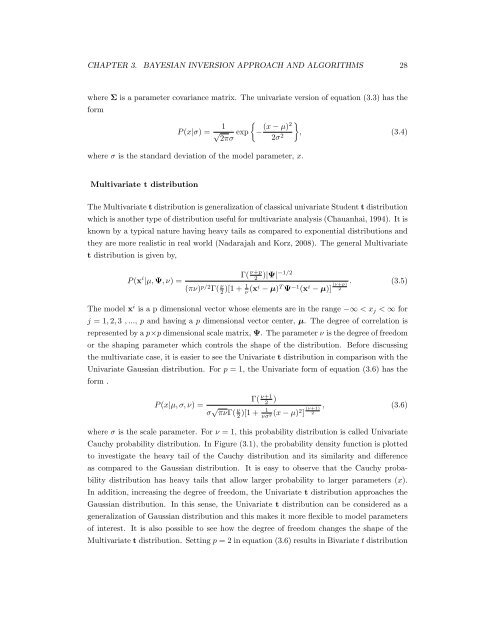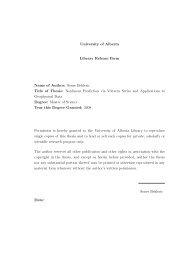Regularization of the AVO inverse problem by means of a ...
Regularization of the AVO inverse problem by means of a ...
Regularization of the AVO inverse problem by means of a ...
Create successful ePaper yourself
Turn your PDF publications into a flip-book with our unique Google optimized e-Paper software.
CHAPTER 3. BAYESIAN INVERSION APPROACH AND ALGORITHMS 28<br />
where Σ is a parameter covariance matrix. The univariate version <strong>of</strong> equation (3.3) has <strong>the</strong><br />
form<br />
P (x|σ) = 1<br />
<br />
(x − µ)2<br />
√ exp −<br />
2πσ 2σ2 <br />
, (3.4)<br />
where σ is <strong>the</strong> standard deviation <strong>of</strong> <strong>the</strong> model parameter, x.<br />
Multivariate t distribution<br />
The Multivariate t distribution is generalization <strong>of</strong> classical univariate Student t distribution<br />
which is ano<strong>the</strong>r type <strong>of</strong> distribution useful for multivariate analysis (Chauanhai, 1994). It is<br />
known <strong>by</strong> a typical nature having heavy tails as compared to exponential distributions and<br />
<strong>the</strong>y are more realistic in real world (Nadarajah and Korz, 2008). The general Multivariate<br />
t distribution is given <strong>by</strong>,<br />
P (x i |µ, Ψ, ν) =<br />
Γ( ν+p<br />
2 )|Ψ|−1/2<br />
(πν) p/2Γ( ν 1<br />
2 )[1 + ν (xi − µ) T Ψ−1 (xi − µ)] (ν+p)<br />
2<br />
. (3.5)<br />
The model x i is a p dimensional vector whose elements are in <strong>the</strong> range −∞ < xj < ∞ for<br />
j = 1, 2, 3 , ..., p and having a p dimensional vector center, µ. The degree <strong>of</strong> correlation is<br />
represented <strong>by</strong> a p×p dimensional scale matrix, Ψ. The parameter ν is <strong>the</strong> degree <strong>of</strong> freedom<br />
or <strong>the</strong> shaping parameter which controls <strong>the</strong> shape <strong>of</strong> <strong>the</strong> distribution. Before discussing<br />
<strong>the</strong> multivariate case, it is easier to see <strong>the</strong> Univariate t distribution in comparison with <strong>the</strong><br />
Univariate Gaussian distribution. For p = 1, <strong>the</strong> Univariate form <strong>of</strong> equation (3.6) has <strong>the</strong><br />
form .<br />
P (x|µ, σ, ν) =<br />
Γ( ν+1<br />
2 )<br />
σ √ πνΓ( ν 1<br />
2 )[1 + νσ2 (x − µ) 2 ] (ν+1)<br />
2<br />
, (3.6)<br />
where σ is <strong>the</strong> scale parameter. For ν = 1, this probability distribution is called Univariate<br />
Cauchy probability distribution. In Figure (3.1), <strong>the</strong> probability density function is plotted<br />
to investigate <strong>the</strong> heavy tail <strong>of</strong> <strong>the</strong> Cauchy distribution and its similarity and difference<br />
as compared to <strong>the</strong> Gaussian distribution. It is easy to observe that <strong>the</strong> Cauchy proba-<br />
bility distribution has heavy tails that allow larger probability to larger parameters (x).<br />
In addition, increasing <strong>the</strong> degree <strong>of</strong> freedom, <strong>the</strong> Univariate t distribution approaches <strong>the</strong><br />
Gaussian distribution. In this sense, <strong>the</strong> Univariate t distribution can be considered as a<br />
generalization <strong>of</strong> Gaussian distribution and this makes it more flexible to model parameters<br />
<strong>of</strong> interest. It is also possible to see how <strong>the</strong> degree <strong>of</strong> freedom changes <strong>the</strong> shape <strong>of</strong> <strong>the</strong><br />
Multivariate t distribution. Setting p = 2 in equation (3.6) results in Bivariate t distribution









